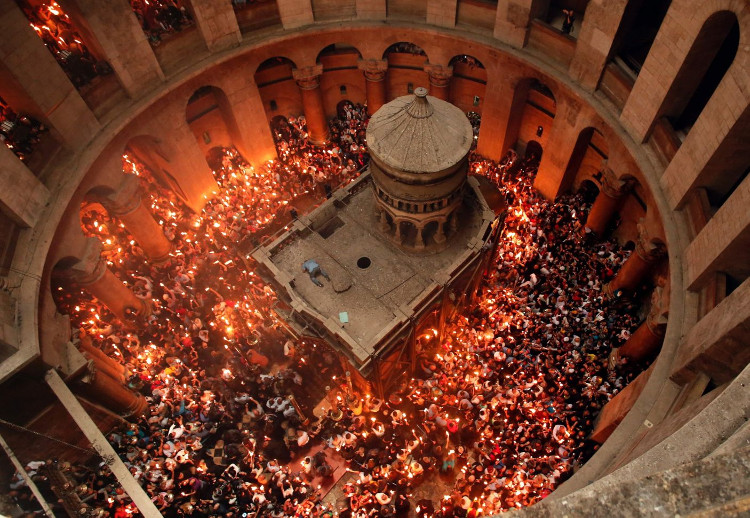Experts determine how the year of Jesus' tomb was built.
The clue from the mortar layer revealed the legend of the remains of the remains of 1,700 years, far beyond the previous guess.
For centuries, in Jerusalem experienced countless devastations, fires and earthquakes. The church was completely destroyed in 1009 and rebuilt later, prompting scholars of the time to doubt whether this could be the burial place of Jesus as a Roman emissary once identified 17 centuries ago. is not.
The results of the scientific tests by the National Geographic Association's expert team confirm the remnants of the limestone cave inside the church are what remains of the grave.

The Edicule shrine was built on the tomb of Jesus.(Photo: Newsweek).
Mortar samples taken from between the original limestone face of the grave and grave marble grave date back to about 345. According to historical records, the tomb was discovered and built by the Romans. The upper cover was around 326. Earlier, the oldest architectural evidence found inside and around the grave complex dates back to the Crusades, indicating that the tomb is no more than 1,000 years old.
Although archaeologists, the experts could not conclude that the grave is actually a burial place for Jesus in Nazareth, the New Testament followers were executed in Jerusalem in the year 30 or 33, the results of the new date. prove the original tomb built under Constantine, the first Roman Catholic emperor.
The tomb was opened for the first time in many centuries in October 2016, when the shrine covered the tomb called Edicule underwent a comprehensive renovation by an interdisciplinary team of experts from the National Athens University of Technology. show.
Several samples of mortar from various locations within Edicule were collected by experts at that time to determine the date and the results of the project of the restoration of Edicule, by Antonia Moropoulou and presented to the Association of Places. National Management
When Constantine's messenger arrived in Jerusalem in 325 in search of a tomb, they were assigned to a Roman temple built 200 years earlier. The Roman temple was demolished and the excavations underneath revealed a grave deep into the limestone cave. The cave was destroyed to reveal the interior of the tomb and the Edicule shrine built around the grave.
A characteristic of the tomb is the long stone slab or "burial bed", where the body of Jesus was placed after his execution. The long stones and small cavities carved from limestone caves are a common feature in the tombs of wealthy Jews in 1st century Jerusalem.
Experts identified the marble sheet covering the "burial bed" most recently installed in 1555 and most likely existed there since the middle of the 14th century, according to pilgrims.
Spot the dust under the marble slab covering the tomb of Jesus.(Video: National Geographic).
When the grave was opened on the evening of October 26, 2016, scientists were very uneasy thanks to finding an object under the marble panel. It was an older marble slab that was carved with a crucifix, right above the original limestone face of the "burial bed".
Some researchers speculate that this older stone slab could be placed under the Crusade, while other scholars set the timeline earlier. They thought that the stone might have existed before and broke when the church was destroyed in 1009. However, no one dared to claim that this was the true evidence of the Roman altar built at first.
The new test results help researchers conclude that the underlying slab is definitely covered with lime to fix it in the 3rd - 4th century on the orders of Emperor Constantine.

Mortar helps experts dating the tomb of Jesus.(Photo: National Geographic).
Limestone specimens from limestone beds were independently analyzed in two laboratories using optically stimulated luminescence (OSL). This technique helps to reveal the last moment quartz inside the masonry block is exposed to light. "Obviously, that time is a milestone for any activity of Emperor Constantine. This is remarkable , " said archaeologist Martin Biddle, who studies the tomb of Jesus.
Reports of test results will be published in the upcoming issue of Archaeological Science: Reports. After completing the conservation work, scientists hope to replace the marble cladding with a material that allows visitors to admire the inside of the tomb.
- Found the tomb of Jesus?
- Inside the church contains the tomb of Jesus
- The shrine on the tomb of Jesus is completed
- The tomb of Jesus was opened for the first time
- The tomb of Jesus in Jerusalem is in danger of collapse
- Ancient tomb marks prove that Jesus once had a wife and son
- New discovery after opening the cap of Jesus' tomb
- The reason that motivates the scientific community to open the tomb of Jesus
- The search for the living descendant of Jesus
- Tomb of Jesus is about to open
- Discover the stone bed Jesus Christ lay when he was buried
- Ancient letter of 2000 years of portrait painting of Jesus
 Discovered an ancient centipede fossil 99 million years old
Discovered an ancient centipede fossil 99 million years old Discovered bat-like dinosaurs in China
Discovered bat-like dinosaurs in China Discovered a 200-year-old bronze cannon of the coast
Discovered a 200-year-old bronze cannon of the coast Discover 305 million-year-old spider fossils
Discover 305 million-year-old spider fossils